Related Research Articles

Eucalyptus is a genus of more than 700 species of flowering plants in the family Myrtaceae. Most species of Eucalyptus are trees, often mallees and a few are shrubs. Along with several other genera in the tribe Eucalypteae, including Corymbia and Angophora, they are commonly known as eucalypts. Plants in the genus Eucalyptus have bark that is either smooth, fibrous, hard or stringy, the leaves have oil glands, and the sepals and petals are fused to form a "cap" or operculum over the stamens. The fruit is a woody capsule commonly referred to as a "gumnut".

Hartz Mountains National Park is located in the south of Tasmania, Australia. It is one of 19 Tasmanian National Parks, and in 1989 it was included in the Tasmanian Wilderness World Heritage Area, in recognition of its natural and cultural values. The Hartz Mountains were named after the Harz mountain range in Germany.
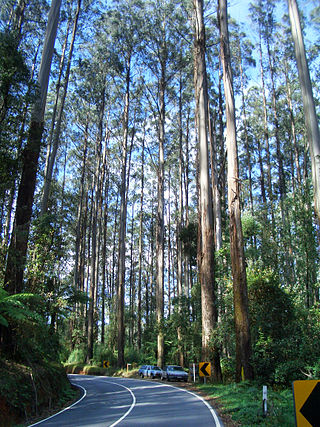
Eucalyptus regnans, known variously as mountain ash, swamp gum, or stringy gum, is a species of medium-sized to very tall forest tree that is native to the Australia states of Tasmania and Victoria. It is a straight-trunked tree with smooth grey bark, but with a stocking of rough brown bark at the base, glossy green, lance-shaped to curved adult leaves, flower buds in groups of between nine and fifteen, white flowers, and cup-shaped or conical fruit. It is the tallest of all flowering plants; the tallest measured living specimen, named Centurion, stands 100 metres tall in Tasmania.
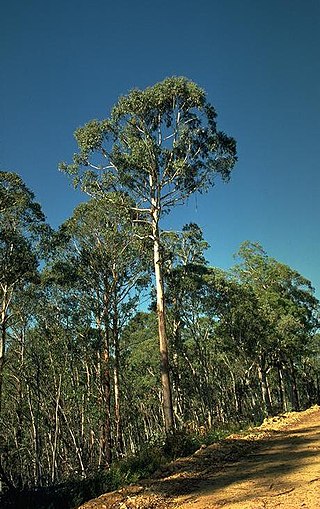
Eucalyptus delegatensis, commonly known as alpine ash, gum-topped stringybark, white-top and in Victoria as woollybutt, is a species of tree that is endemic to southeastern Australia. It has a straight trunk with rough, fibrous to stringy bark on the lower half of the trunk, smooth white bark above, lance-shaped to curved adult leaves, flower buds in groups of between seven and fifteen, white flowers and barrel-shaped or hemispherical fruit.

The Strzelecki Ranges is a set of low mountain ridges located in the West Gippsland and South Gippsland regions of the Australian state of Victoria.
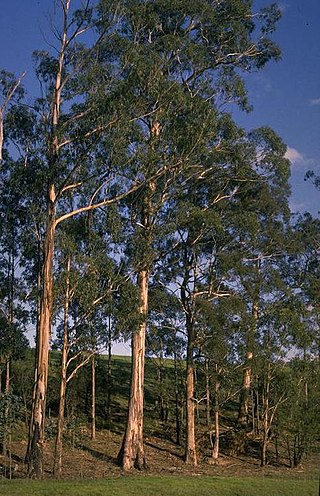
Eucalyptus globulus, commonly known as southern blue gum or blue gum, is a species of flowering plant in the family Myrtaceae. It is a tall, evergreen tree endemic to southeastern Australia. This Eucalyptus species has mostly smooth bark, juvenile leaves that are whitish and waxy on the lower surface, glossy green, lance-shaped adult leaves, glaucous, ribbed flower buds arranged singly or in groups of three or seven in leaf axils, white flowers and woody fruit.

Eucalyptus obliqua, commonly known as messmate stringybark or messmate, but also known as brown top, brown top stringbark, stringybark or Tasmanian oak, is a species of tree that is endemic to south-eastern Australia. It has rough, stringy or fibrous bark on the trunk and larger branches, smooth greyish bark on the thinnest branches, lance-shaped to curved adult leaves, flower buds in groups of seven to fifteen or more, white flowers and cup-shaped or barrel-shaped fruit.
Victorian ash can refer to the wood of either of the trees Eucalyptus regnans or Eucalyptus delegatensis, when it is sourced from the Australian state of Victoria. The same wood sourced from Tasmania is called Tasmanian oak. It is the most common (wood-based) building material used in Australia. Most furniture in Australia is made of Victorian Ash.
Riekoperla darlingtoni, the Mount Donna Buang wingless stonefly, is a species of stonefly in the family Gripopterygidae, which is endemic to Australia.

The Styx River is a perennial river in the centre of southern Tasmania, Australia. The upper reaches of the Styx River are in the Tasmanian Wilderness, south west of Maydena. The river is a popular destination for river-rafting and canoeing.

Abantiades latipennis, known as the Pindi moth, is a species of moth in the family Hepialidae. It may also be referred to as a swift moth or a ghost moth, as this is a common name associated with Hepialidae. Endemic to Australia and identified in 1932, it is most populous in temperate rainforest where eucalypti are prevalent, as the larvae feed primarily on the roots of these trees. Females lay eggs during flight in a scattering fashion. The larvae live for over eighteen months underground, while adult moths survive for approximately one week, as they have no mouthparts with which to feed. The moths are preyed upon by a number of predators, including bats and owls. Brown in colour overall, males are paler and the identifying silver bars of the male's wings are more prominent than those of the female's, with dark margins. Male adults are generally smaller.

Stictea macropetana, the eucalyptus leafroller, is a moth of the family Tortricidae. It is native to Australia, but is an introduced species in New Zealand, where it was first recorded in 1921. It was first described by Edward Meyrick in 1881.

Thismia rodwayi, also known as a fairy lantern, is a non-chlorophyllous plant belonging to the Burmanniaceae family, found in the southern states of Australia and in several locations in New Zealand.
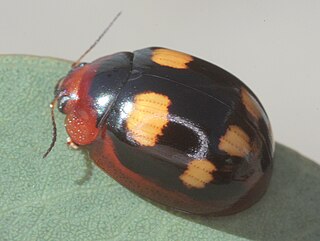
Paropsisterna is a genus of leaf beetles indigenous to Papua New Guinea and Australia. There are over 120 species, many with bright aposematic colours, and many feeding on Eucalyptus leaves.
Australian wormy chestnut or firestreak is a common name for lumber of Eucalyptus obliqua, Eucalyptus sieberi and Eucalyptus fastigata grown in Victoria, southern New South Wales, and Tasmania in Australia. It is a hardwood species commonly used in flooring applications.
Scabby Range Nature Reserve is a heritage-listed protected area at Sams River Fire Trail, Yaouk, New South Wales, Australia. It was established on 3 December 1982 and added to the former Australian Register of the National Estate on 30 June 1992. It was added to the Australian National Heritage List as part of the Australian Alps National Parks and Reserves on 7 November 2008.

Tetratheca pilosa is a flowering plant in the family Elaeocarpaceae, endemic to Australia. It is a small shrub found in dry sclerophyll forests, open heathlands and woodlands of Australia. It was first recorded in 1805 by French botanist Jacques Labillardière.
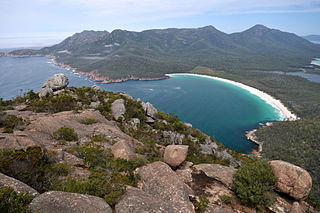
The Tasmanian temperate forests is a temperate broadleaf and mixed forests ecoregion in Australia. The ecoregion occupies the eastern portion of the island of Tasmania, which lies south of the Australian mainland.
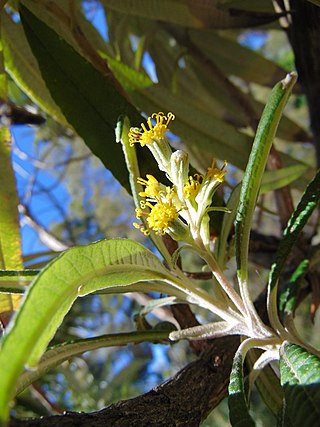
Bedfordia salicina, commonly known as Tasmanian blanketleaf, is an endemic angiosperm of Tasmania, Australia. It is widespread throughout wet sclerophyll forests, moist gullies and intermediate forests and woodlands between wet and dry sclerophyll communities. Bedfordia salicina is abundant at low elevations, on dolerite, sandstone and mudstone substrate, east of Tylers line. Alternating leaves droop down to blanket the stem, coining the species common name, blanketleaf.
References
- 1 2 3 "Tasmanian Oak Information". TimberPlus.
- ↑ "Tasmanian Timber Species". Tasmanian Timber Promotion Board. Retrieved 2009-08-31.